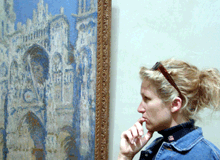The
Three Islanders: Art Historians, Artists, Public
By Rose Marie Gnausch

The Art Historian
Ideally, he is in love - with art. Though from a temporal and spatial
distance. His position is of highest importance in the art world, yet
his encounter with the artwork is rare, the encounter with the artists
almost inexistent.
The art historian is looking for art he appreciates, stirs his interest
and is concordant to his preconceived ideas. His function is to evaluate,
to comment and determine art historical artifacts. Through the discovery
and re-discovery of artistic positions the work of the art historian is
of great value since s/he literally ‘creates’ these artistic
positions form the past by bringing them back to contemporary awareness.
Georges de la Tour and Vermeer are prominent examples of art historical
re-discovery. The reception of these artists is of equal value to critics,
historians and artists alike. Yet the inexistent link between artist,
artwork and historian is an unsolved riddle.
The critic
His love for art is a little less Romantic than the one of the art historian.
Searching for newness, the exceptional, he wants to change and mold the
contemporary art scene according to his own convictions. To avoid strong
subjective approaches he yields to variety. The critic determines the
contemporary scene, the exhibition politics, the reception and helas the
art production. But who but the critic dares to judge the jungle of contemporary
artistic practice? Therefore he constitutes a very important pioneer in
the field of art. According to his choice and value judgment, the dealer
will chose his exhibition plan, the collector is able to acquire and the
museum able to test the artist’s contemporary value.
The artist
Ideally obsessed and inspired from his idea of the world. Yet often in
direct dependency to the critic, since it is through the critic that the
artist achieves recognition. The artist does not admit this dependency.
He claims to produce art in total independence. Is supposedly indifferent
to criticism or public opinion since it would undermine artistic freedom.
The artist is looking to realize his ideas, while the critic is looking
to realize his own. When they are concordant, the public will know the
art. The temptation is therefore high to find out what the critic wants
in order to be able to enjoy a recognized artist’s life.
This interdependence is what the project dis-positiv constitutes. The
artist is invisible. Behind the scene critics dominate the space of art.
Those artists who do not search the contact with the world of the words,
create- mostly unknown in the many studios around the world. A few do
not seek, and yet they find…
The artist pretends not to follow the critics opinion, equally the critic
and art historian deliberately ignore the artist’s statement- if
they do no fit the sought after discourse. Both sides build their own
world. Connected only through the object- yes it mostly still exists the
art object. But it is on the verge of disappearance as well. Then there
will be no more need of an artist, just as a phantom pretext, in words,
in the discourse.
The educators
They have the difficult job in educating the public about art. The public,
the world outside (?) the arts has many questions, curiosity and interest
in the field. But nobody shows any patience to this behavior. If the public
does not understand art, it is of no interest to artist or critic. The
public should start thinking. It is all about thinking, not easy consumption.
Please! Use your brain cells, there is no need for art educators, the
work of art speaks for itself, no third party comment is required, states
the artists and rejects all intermediates between his work and the public.
The artist has a point. If the work speaks for itself, no need of any
intellectual explanation. Fact is that the public does simply not understand
the doings of the contemporary art world: whose is to be accused? Is it
the fault of the artists who is unable to bring his work to the point
of mutual agreement, or is it the ignorance of the public? Ivory Tower
inhabitants, says one side. Think for yourself, replies the other.
The public
Has no right to ask unqualified questions. A typical question such as
why is this art? Is of no use, too many times the educator has attempted
to answer this far to complex question. But why is there art, if we cannot
define it? The public is threatened by those that run the show: the critics,
educators, artists, and dealers. The public needs no help. The educator
at least should help. But s/he is mostly an islander too, mostly art historian,
sometimes artists. Seldom both.
The three islanders: critic, artist, public all live separately. From
time to time there is an interest of crossing over, but how? For the public
there is only the educator. The critic goes on his own, to the island
of the artist, makes it his. The artist desperately lucks over to the
island of the critic.
Shedding light on this situation of self-interest and exclusion, dis-positiv
does a marvelous job: with great subtlety the critic, the artists and
the public is made aware of the current situation. Not with words, but
through living the experience, of what we consider art today. Dis-positiv
allows to literally feeling the scene as a complex net of fabricated interrelationships.
Highly recommended to see for yourself, whenever it comes to your island.
Revised for English edition in Winter 2003.
Rose Marie Gnausch, 1969 born in Haan/Rhl. Artist, art educator and art historian. Worked since 1992 as a critic and educator in South of France and New York. Headed the educational program at dis-positiv Berlin in April 2003. Since Fall 2003 Senior Lecturer at Eastern Mediterranean University, Cyprus.